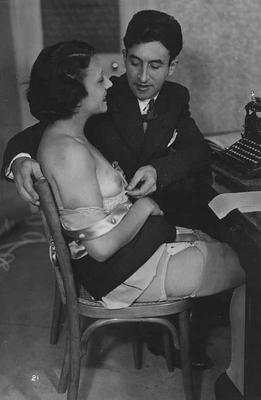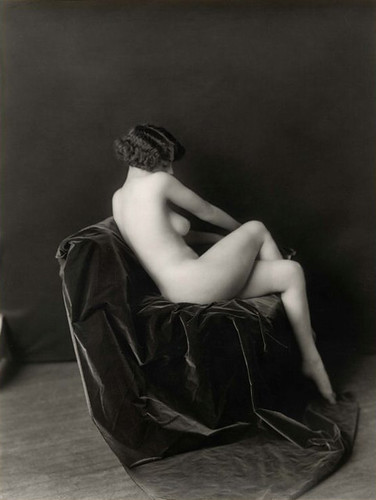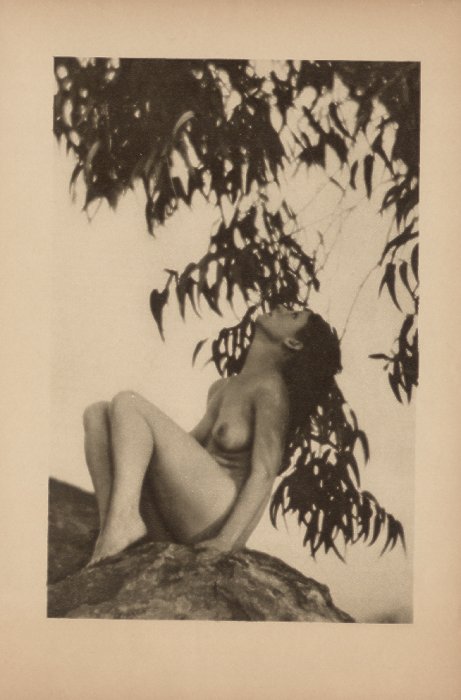
if you recreating classic cuisine from the early 20th cent..u need a consomme, followed by a fish/seafood dish, then a remove or an entree, then the roast (game pref in suitable sauce) and finish off with a sorbet or parfait..u also need 2 look at the classic table settings..big pile of cut flowers in small glass vases in middle, nice plates, napkins and appropri8 sets of knives/spoons.  For wines try a selection from Chateau Montrose '37, Champagne Irroy '50, or Pouilly Fuisse '56In the 1920's Caesar Cardini (1896-1956) had a small hotel in Mexico not far from the California border.
For wines try a selection from Chateau Montrose '37, Champagne Irroy '50, or Pouilly Fuisse '56In the 1920's Caesar Cardini (1896-1956) had a small hotel in Mexico not far from the California border. The Hollywood crowd and San Diego socialites would drive to Mexico to party in those days of Prohibition, and often they wound up at Caesar's Hotel for a meal before returning home.
The Hollywood crowd and San Diego socialites would drive to Mexico to party in those days of Prohibition, and often they wound up at Caesar's Hotel for a meal before returning home.  The story is told that on the Fourth of July, 1924, people arrived in droves, crowding the restaurant and sending the kitchen into a panic. There weren't enough fresh vegetables to go around, and in those days Americans weren't wild about salad, but Caesar thought he could make a salad they'd really go for, and he would make it in public -- tableside.
The story is told that on the Fourth of July, 1924, people arrived in droves, crowding the restaurant and sending the kitchen into a panic. There weren't enough fresh vegetables to go around, and in those days Americans weren't wild about salad, but Caesar thought he could make a salad they'd really go for, and he would make it in public -- tableside.  Using ingredients that are basic to every Italian kitchen, he took lettuce (romaine or cos, as pictured above), garlic-flavored olive oil, salt and pepper, lemon juice, parmesan cheese, croutons, a little Worcestershire sauce, and a coddled egg, and he created a salad that looked so good that every table of diners ordered one.
Using ingredients that are basic to every Italian kitchen, he took lettuce (romaine or cos, as pictured above), garlic-flavored olive oil, salt and pepper, lemon juice, parmesan cheese, croutons, a little Worcestershire sauce, and a coddled egg, and he created a salad that looked so good that every table of diners ordered one. Over the years, it became quite the thing to do, to drive to Tijuana for a Caesar Salad. Clark Gable, Jean Harlow, and W.C. Fields came, and gossip columnists wrote about it in the newspapers.
Over the years, it became quite the thing to do, to drive to Tijuana for a Caesar Salad. Clark Gable, Jean Harlow, and W.C. Fields came, and gossip columnists wrote about it in the newspapers.  In 1948 the Cardinis moved to Los Angeles to be closer to their patrons, and when people began bringing bottles for Caesar to fill with his salad dressing, a new cottage industry was born, and Cardini began packaging it for consumers all over the world.
In 1948 the Cardinis moved to Los Angeles to be closer to their patrons, and when people began bringing bottles for Caesar to fill with his salad dressing, a new cottage industry was born, and Cardini began packaging it for consumers all over the world.  Bearing in mind that the dish originated in Mexico, in 1953 the Society of Epicures in Paris reportedly called the Caesar Salad "the greatest recipe to originate from the Americas in 50 years."
Bearing in mind that the dish originated in Mexico, in 1953 the Society of Epicures in Paris reportedly called the Caesar Salad "the greatest recipe to originate from the Americas in 50 years." 
Today many restaurants as well as home chefs add such ingredients as cooked chicken, shrimp or lobster to the salad for a main dish. However, the most frequent additions to the original recipe are anchovies and vinegar, which were never in the original, although there is a taste of anchovy in the Worcestershire sauce Caesar added.
However, the most frequent additions to the original recipe are anchovies and vinegar, which were never in the original, although there is a taste of anchovy in the Worcestershire sauce Caesar added. 
Authentication from Rosa Cardini, her father's heir to the Cardini Salad Dressing company, comes for the following method of making
CAESAR'S SALAD
1/2 cup day-old bread, cubed
3/4 cup garlic oil**, divided use
2 small heads romaine lettuce
1/2 teaspoon salt
1/2 teaspoon freshly ground pepper
2 eggs*, coddled (boiled in the shell for 1 minute)
Juice of 2 medium lemons
8-10 drops of Worcestershire sauce
1/2 cup freshly grated Parmesan cheese
1. To prepare the garlic oil, place 4-5 cloves of garlic**, peeled and quartered, in a good quality (e.g. Extra Virgin) olive oil and let it stand at room temperature several hours or even up to 5 days.
2. To prepare croutons, pre-heat oven to 225 degrees. Toss bread cubes with 1/4 cup garlic oil and spread on a pan or baking sheet. Toss frequently and bake until golden brown, about 2 hours.
3. Wash, dry and crisp (in the refrigerator) the leaves of the romaine lettuce. Originally, Caesar left the lettuce leaves whole, and the salad was eaten with the fingers, but later he tore the outer leaves into 2-inch lengths, leaving only the small inner leaves whole, and the salad was eaten with a fork.
4. Place lettuce in a large bowl and toss with remaining 1/2 cup of garlic oil. Add salt and pepper, again tossing gently. Break the coddled eggs* over the lettuce, add lemon juice and Worcestershire sauce and toss two or three times. Add croutons and cheese. Toss lightly once more.
Serves 4.
"With the passing of the war, America settled down to begin an era of onrushing prosperity. But it was also the era of Prohibition. I glance into menus, from 1921 on: Menus for dinners to honor such figures as Charles M. Schwab...Another significant change was evident in this era, as my menus show. The banquets became less sumptuous--more, shall I say, utilitarian?
Menus for dinners to honor such figures as Charles M. Schwab...Another significant change was evident in this era, as my menus show. The banquets became less sumptuous--more, shall I say, utilitarian? Certainly, the courses had been pared down. For instance, a dinner in February, 1924, for President Coolidge. (Note the "Appolinaris" and "White Rock" but no mention whatever of any wines or liquors.) Here is the menu:
Certainly, the courses had been pared down. For instance, a dinner in February, 1924, for President Coolidge. (Note the "Appolinaris" and "White Rock" but no mention whatever of any wines or liquors.) Here is the menu:
 Canape of Anchovies
Canape of Anchovies
Cream of Celery with Toasties
Celery Olives
Aiguillette of Striped Bass Joinville
Potatoes a la Hollandaise
Medaillon of Spring Lamb, Chasseur
Asparagus Tips au Gratin
***
Breast of Chicken a la Rose
Waldorf Salad, Mayonnaise
***
 Venetian Ice Cream
Venetian Ice Cream
Assorted Cakes Coffee
Apollinaris White Rock."
 For wines try a selection from Chateau Montrose '37, Champagne Irroy '50, or Pouilly Fuisse '56In the 1920's Caesar Cardini (1896-1956) had a small hotel in Mexico not far from the California border.
For wines try a selection from Chateau Montrose '37, Champagne Irroy '50, or Pouilly Fuisse '56In the 1920's Caesar Cardini (1896-1956) had a small hotel in Mexico not far from the California border. The Hollywood crowd and San Diego socialites would drive to Mexico to party in those days of Prohibition, and often they wound up at Caesar's Hotel for a meal before returning home.
The Hollywood crowd and San Diego socialites would drive to Mexico to party in those days of Prohibition, and often they wound up at Caesar's Hotel for a meal before returning home.  The story is told that on the Fourth of July, 1924, people arrived in droves, crowding the restaurant and sending the kitchen into a panic. There weren't enough fresh vegetables to go around, and in those days Americans weren't wild about salad, but Caesar thought he could make a salad they'd really go for, and he would make it in public -- tableside.
The story is told that on the Fourth of July, 1924, people arrived in droves, crowding the restaurant and sending the kitchen into a panic. There weren't enough fresh vegetables to go around, and in those days Americans weren't wild about salad, but Caesar thought he could make a salad they'd really go for, and he would make it in public -- tableside.  Using ingredients that are basic to every Italian kitchen, he took lettuce (romaine or cos, as pictured above), garlic-flavored olive oil, salt and pepper, lemon juice, parmesan cheese, croutons, a little Worcestershire sauce, and a coddled egg, and he created a salad that looked so good that every table of diners ordered one.
Using ingredients that are basic to every Italian kitchen, he took lettuce (romaine or cos, as pictured above), garlic-flavored olive oil, salt and pepper, lemon juice, parmesan cheese, croutons, a little Worcestershire sauce, and a coddled egg, and he created a salad that looked so good that every table of diners ordered one. Over the years, it became quite the thing to do, to drive to Tijuana for a Caesar Salad. Clark Gable, Jean Harlow, and W.C. Fields came, and gossip columnists wrote about it in the newspapers.
Over the years, it became quite the thing to do, to drive to Tijuana for a Caesar Salad. Clark Gable, Jean Harlow, and W.C. Fields came, and gossip columnists wrote about it in the newspapers.  In 1948 the Cardinis moved to Los Angeles to be closer to their patrons, and when people began bringing bottles for Caesar to fill with his salad dressing, a new cottage industry was born, and Cardini began packaging it for consumers all over the world.
In 1948 the Cardinis moved to Los Angeles to be closer to their patrons, and when people began bringing bottles for Caesar to fill with his salad dressing, a new cottage industry was born, and Cardini began packaging it for consumers all over the world.  Bearing in mind that the dish originated in Mexico, in 1953 the Society of Epicures in Paris reportedly called the Caesar Salad "the greatest recipe to originate from the Americas in 50 years."
Bearing in mind that the dish originated in Mexico, in 1953 the Society of Epicures in Paris reportedly called the Caesar Salad "the greatest recipe to originate from the Americas in 50 years." 
Today many restaurants as well as home chefs add such ingredients as cooked chicken, shrimp or lobster to the salad for a main dish.
 However, the most frequent additions to the original recipe are anchovies and vinegar, which were never in the original, although there is a taste of anchovy in the Worcestershire sauce Caesar added.
However, the most frequent additions to the original recipe are anchovies and vinegar, which were never in the original, although there is a taste of anchovy in the Worcestershire sauce Caesar added. 
Authentication from Rosa Cardini, her father's heir to the Cardini Salad Dressing company, comes for the following method of making
1/2 cup day-old bread, cubed
3/4 cup garlic oil**, divided use
2 small heads romaine lettuce
1/2 teaspoon salt

1/2 teaspoon freshly ground pepper
2 eggs*, coddled (boiled in the shell for 1 minute)
Juice of 2 medium lemons
8-10 drops of Worcestershire sauce
1/2 cup freshly grated Parmesan cheese

1. To prepare the garlic oil, place 4-5 cloves of garlic**, peeled and quartered, in a good quality (e.g. Extra Virgin) olive oil and let it stand at room temperature several hours or even up to 5 days.

2. To prepare croutons, pre-heat oven to 225 degrees. Toss bread cubes with 1/4 cup garlic oil and spread on a pan or baking sheet. Toss frequently and bake until golden brown, about 2 hours.

3. Wash, dry and crisp (in the refrigerator) the leaves of the romaine lettuce. Originally, Caesar left the lettuce leaves whole, and the salad was eaten with the fingers, but later he tore the outer leaves into 2-inch lengths, leaving only the small inner leaves whole, and the salad was eaten with a fork.

4. Place lettuce in a large bowl and toss with remaining 1/2 cup of garlic oil. Add salt and pepper, again tossing gently. Break the coddled eggs* over the lettuce, add lemon juice and Worcestershire sauce and toss two or three times. Add croutons and cheese. Toss lightly once more.

Serves 4.
"With the passing of the war, America settled down to begin an era of onrushing prosperity. But it was also the era of Prohibition. I glance into menus, from 1921 on:
 Certainly, the courses had been pared down. For instance, a dinner in February, 1924, for President Coolidge. (Note the "Appolinaris" and "White Rock" but no mention whatever of any wines or liquors.) Here is the menu:
Certainly, the courses had been pared down. For instance, a dinner in February, 1924, for President Coolidge. (Note the "Appolinaris" and "White Rock" but no mention whatever of any wines or liquors.) Here is the menu:  Canape of Anchovies
Canape of AnchoviesCream of Celery with Toasties
Celery Olives
Aiguillette of Striped Bass Joinville
Potatoes a la Hollandaise
Medaillon of Spring Lamb, Chasseur
Asparagus Tips au Gratin

***
Breast of Chicken a la Rose
Waldorf Salad, Mayonnaise
***
 Venetian Ice Cream
Venetian Ice CreamAssorted Cakes Coffee
Apollinaris White Rock."

No comments:
Post a Comment